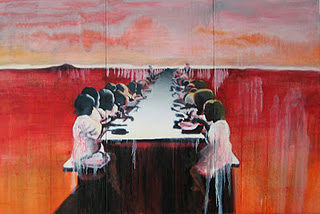

To know what we are, we must know where we come from. The past is often muddled, memory fails us, often familial histories are selective and leave out the painful moments. Somerville artist Hope Ricciardi addresses her ancestral past through her evocative art. Sadly, past generations of her clan were victims of the Armenian Genocide. This tragic event occurred in the early part of the last century when many Armenians were slaughtered or thrown into a diaspora by the Turks. Often this tragedy has been overshadowed by the Jewish Holocaust that was engineered by the nefarious forces of Nazi Germany. Ricciardi’s art brings the Genocide in the forefront with her skillful brush, and unique sensibility.
Ricciardi, who has a space at the Joy Street Studios states on her website: ” My ancestry and roots in Armenian history are the catalyst for my current work.” In 2011 her exhibition “History Ignored” that dealt with her roots in Armenian history was presented at Galatea Fine Art Gallery in Boston. She works in photo transfers and plaster gesso (fluid white coating, composed of plaster of paris, chalk, gypsum, or other whiting mixed with glue, applied to smooth surfaces such as wood panels, plaster, stone, or canvas to provide the ground for tempera and oil painting ) on various surfaces including canvas, linen and panels. She has an exhibit of her work at Arsenal Center of the Arts in Watertown, Mass that will run through Jan. 2, 2011.
Ricciardi lives in Franklin, Mass. and commutes to her studio in Somerville. The Joy Street Studios building is a converted factory where a diverse group of artists work. Ricciardi reflected on working in the suburbs, like Franklin as opposed to a city like Somerville: ” Working in Franklin is like working in a vacuum. I once tried to exhibit some abstract nudes in the Town Hall and they wound up in some closet. I really need the artistic energy of place like Somerville to keep me going.”
Ricciardi trained at the Museum School in Boston and has taught in a number of private schools. She was Dean of Admissions at the tony Walnut Hill School for the Arts in Natick, Mass. She left that position to devote herself to her art.
Her paintings are haunting and in many cases she uses photographs she has seen as the basis for her work. In one painting ” Lost Youth,” we see a long table of spectral children sitting in the midst of a surreal landscape. The painting depicts the 5,000 or so children who were orphaned and found in the desert in Turkey in 1915–victims of the Armenian Genocide.
Ricciardi who joined me for a famed oatmeal scone at the Sherman Cafe in Union Square seems like a dedicated artist, who wants to recover her past and move on with a clear eye to the future.















Reader Comments